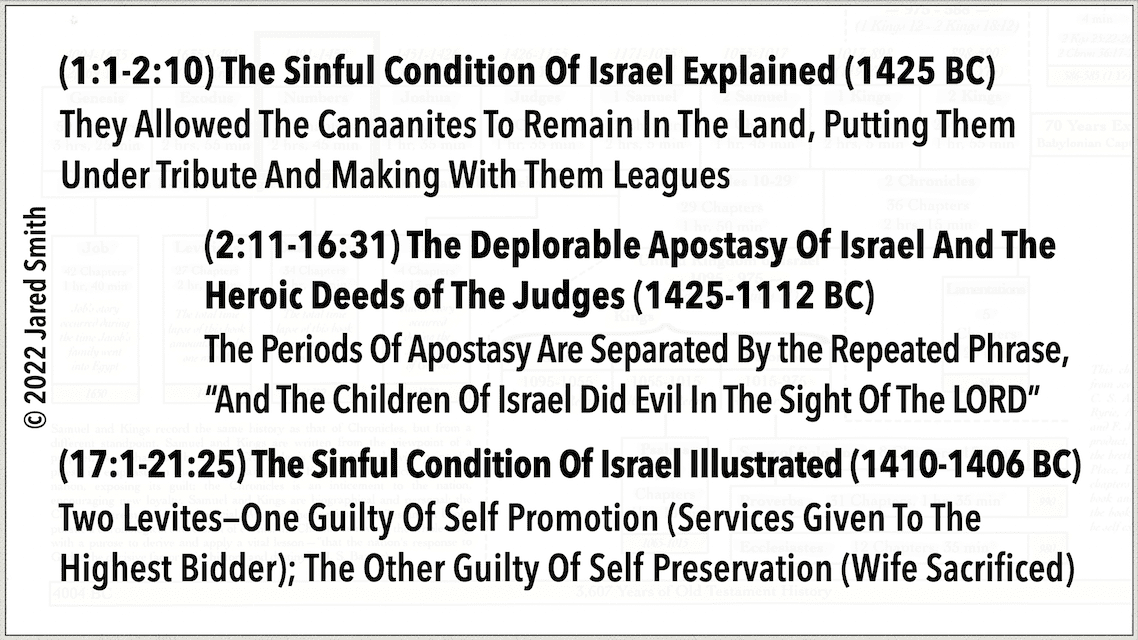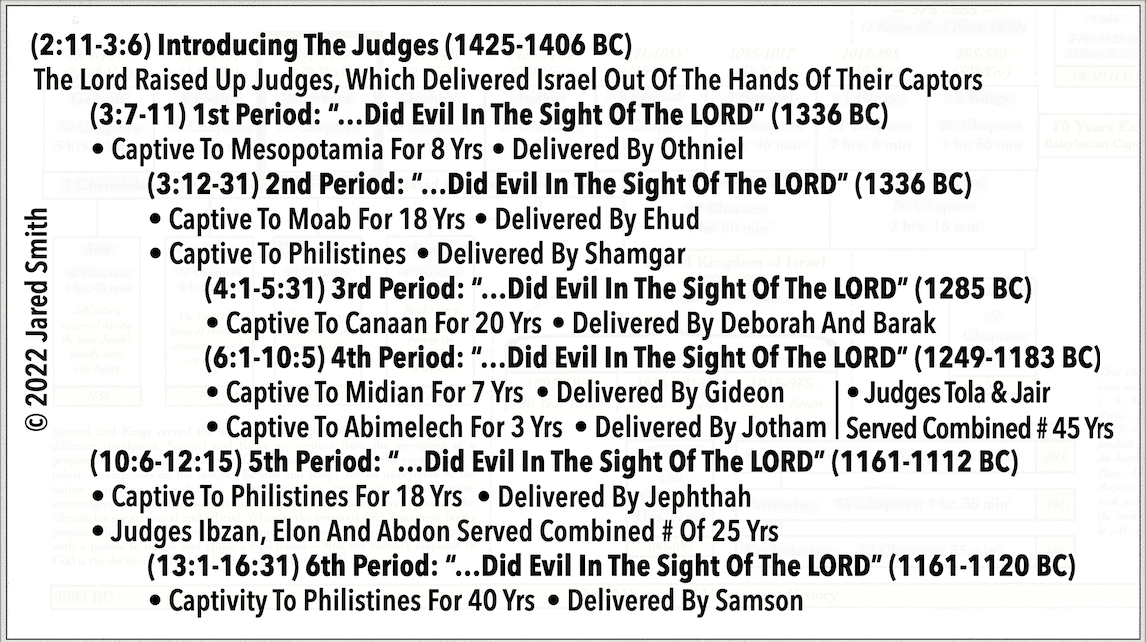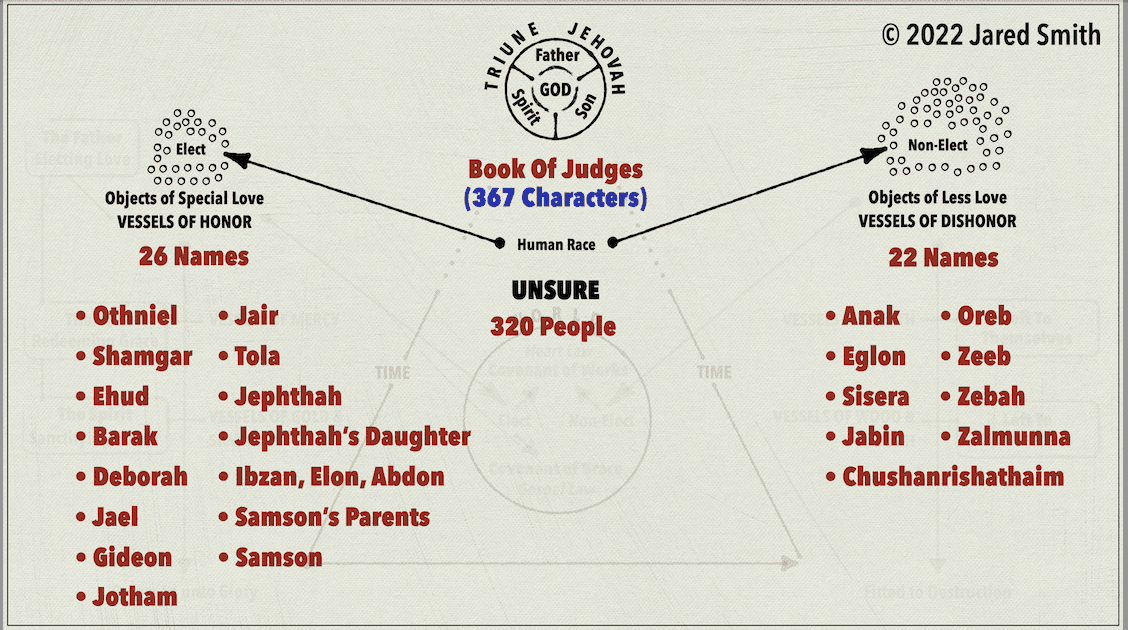21 Bible Reading – The Book Of Judges
A Transcript Of The Video Study
According to the Chronological Chart Of Bible Books, Judges is the eighth book which appears on the timeline. We believe portions of it was written by a number of unknown authors, but that it was completed and compiled by Samuel, sometime after Saul had been appointed king of Israel, around the year 1095 BC. Nevertheless, this is a divinely inspired book, meaning God breathed out His words through those who wrote the book. The words of this book, therefore, are the words of God. They are able to make us wise unto salvation through faith which is in Christ Jesus. They are profitable for doctrine, for reproof, for correction, for instruction in righteousness, that we might be matured in the faith, throughly furnished unto all good works. (2 Tim 3:15-17)
The book receives its name from a period in Israel’s history which was marked by various men and women appointed by God to serve as “Judges” of the people at different stages in the nation’s development. Allow me to give a historic backdrop to the book.
The time of the Judges extends from the death of Joshua to the reign of King Saul, with an overlap during Saul’s reign until Samuel’s death in 1057 BC. Henceforth, the total period of the Judges is around 350 years—270 years are recorded in the book of Judges, whereas the remaining 80 years are recorded in the book of 1 Samuel.
For the 350 years between the death of Joshua and the reign of Saul, there was no king in Israel, but everyone did that which was right in his own eyes. A vicious cycle emerged during these centuries—Israel would forsake the Lord and commit idolatry; the Lord would chastise the people by allowing the Canaanites to conquer and subjugate them; the people would eventually cry out unto the Lord for deliverance; the Lord would send relief by raising up Judges who would free the people from bondage and serve as wise counselors to the nation. This cycle repeated itself time and again, which is why there are more than a dozen Judges belonging to this period of Israel’s history.
This backdrop to the book of Judges is actually explained in Judges 2:10-16: “And also all that generation were gathered unto their fathers: and there arose another generation after them, which knew not the LORD, nor yet the works which he had done for Israel. And the children of Israel did evil in the sight of the LORD, and served Baalim: and they forsook the LORD God of their fathers, which brought them out of the land of Egypt, and followed other gods, of the gods of the people that were round about them, and bowed themselves unto them, and provoked the LORD to anger. And they forsook the LORD, and served Baal and Ashtaroth. And the anger of the LORD was hot against Israel, and he delivered them into the hands of spoilers that spoiled them, and he sold them into the hands of their enemies round about, so that they could not any longer stand before their enemies. Whithersoever they went out, the hand of the LORD was against them for evil, as the LORD had said, and as the LORD had sworn unto them: and they were greatly distressed. Nevertheless the LORD raised up judges, which delivered them out of the hand of those that spoiled them.”
These “judges” were not the typical judges we may think of today, sitting behind a counter and presiding over a courtroom. Rather, they were military leaders who delivered Israel from captivity, and exercised a loose oversight of the people for a limited number of years. Neither must we think of these Judges serving in a regular succession of leadership, as if one Judge was immediately replaced by another Judge, in the way that Joshua immediately followed that of Moses. Rather, they were singular leaders called by God to deliver the people from oppression and administer righteousness to the nation at irregular intervals during the 350 years of this period of Israel’s history.
There are 14 Judges singled out in the book. The order in which they appear are: Othniel, Ehud, Shamgar, Deborah, Barak, Gideon, Jotham, Tola, Jair, Jephthah, Ibzan, Elon, Abdon and Samson.
You will notice that I have included Jotham in the list of Judges, however, his name does not appear on the list on most people’s register. This is largely due to the fact that he is not specifically identified as a Judge of Israel. However, he was the youngest son of Gideon, who stood on the top of a mountain pronouncing a curse upon the people for appointing Abimelech as king. His prophecy came true, as both the people and Abimelech suffered a terrible fate. Henceforth, whether Jotham was or was not a Judge, he is given a prominent place in the book of Judges and so I include him on the list.
There are two Judges who are not recorded in the book and therefore I have left off the list—Eli and Samuel. These men are recorded in the book of 1 Samuel, so we will leave their names off this list and will consider their lives and testimonies when we read 1 Samuel.
The book of Judges has been divided into 21 chapters, and it takes approximately 1 hour and 35 minutes to read it in a single sitting.
Now, allow me to provide an overview of the book’s structure. There are three main sections:
In (1:1-2:10), an explanation is given for Israel’s sinful condition. In essence, rather than driving out the Canaanites from the land, they allowed them to remain in the land, opting to put them under tribute and making with them various treaties and covenants. This explanation is set around 1425 BC.
In (2:11-16:31), the deplorable apostasy of Israel is recorded, along with the heroic deeds of the Judges as they deliver the people from various captivities and guide the nation by righteous counsel. There are seven periods of apostasy highlighted in these chapters, separated by the repeated phrase, “And the children of Israel did evil in the sight of the Lord.” The events which unfold in this section of the book occurred between 1425-1112 BC.
In (17:1-21:25), illustrations are given of Israel’s sinful condition. Although this section of the book appears at the end, yet the time in which the events occurred was around the same year as the first section of the book—1410-1406 BC. You can view the first and last sections of the book as ‘bookends’ to prop up the middle section. There are two illustrations used in this last section, both involving Levites. The first Levite was guilty of self promotion, insomuch that he served the office of a priest to those who paid the highest wage. The second Levite was guilty of self preservation, insomuch that he allowed his wife to be sexually abused by a gang of men in order that he might escape harm free. Both illustrations are chilling and depict in raw imagery the sinful condition of the children of Israel at that time.
Now, if this overview of the book is to be of real help to you, then I must provide some further notes on the middle section, which as you can see, is the main content of the book. As I pointed out earlier, there is a key statement occurring seven times in these chapters, which separates the main movements of the section—“And the children of Israel did evil in the sight of the LORD.”
In (2:11-3:6), the reason for God raising up the Judges to lead the nation of Israel is introduced. The events of this section occurred between 1425-1406 BC.
In (3:7-11), the first of six periods of apostasy is recorded. Certain of the children of Israel were in captivity to Mesopotamia for eight years and delivered by Othniel. This occurred in the year 1336 BC.
In (3:12-31), the second of six periods of apostasy is recorded. Certain of the children of Israel were in captivity to Moab for eighteen years and delivered by Ehud. Others were in another captivity to the Philistines and delivered by Shamgar. This is also occurred in the year 1336 BC.
In (4:1-5:31), the third of six periods of apostasy is recorded. Certain of the children of Israel were in captivity to the Canaanites for twenty years and delivered by Deborah and Barak. This occurred in the year 1285 BC.
In (6:1-10:5), the fourth of six periods of apostasy is recorded. Certain of the children of Israel were in captivity to the Midianites for seven years and delivered by Gideon. Others were in captivity to Abimelech for three years and delivered by Jotham. Tola and Jair also served as Judges for a combined number of 45 years. These events occurred in the years 1249-1183 BC.
In (10:6-12:15), the fifth of six periods of apostasy is recorded. Certain of the children of Israel were in captivity to the Philistines for eighteen years and delivered by Jephthah. Ibzan, Elon and Abdon also served as Judges for a combined number of 25 years. These events occurred in the years 1161-1112 BC.
In (13:1-16:31), the sixth and final period of apostasy is recorded. Certain of the children of Israel were in captivity to the Philistines for forty years and delivered by Samson. This occurred in the years 1161-1120 BC.
Now, not only is this section of the book divided into these seven periods of Israel’s apostasy, together with the various Judges who delivered them, but there is also an interesting interplay of ideas which give shape to an eye-catching structure of the book. If I had the time, I would point out several interesting connections between the these seven periods of apostasy, but as my time is quickly running out, I wish to highlight just a few things which may spark your interest while reading through the book.
First, (2:11-3:6) obviously stands apart from the other six sections, serving as it were, a type of introduction to the Judges. The remaining six sections come under this general heading, being a record of the Judgeships of the men and women set apart by God for that purpose.
Second, there is a correspondence between (3:7-11) and (10:6-12:15). The connection may not appear obvious at first, but when you consider the women involved with each Judgeship, there certainly seems to be an interplay of ideas. Othniel was the younger brother of Caleb, who, having conquered Debir in the earlier part of his ministry, was awarded the daughter of Caleb to wife. Jephthah, on the other hand, vowed to make a burnt offering of the first thing to come out of his house upon his return home, which resulted in him sacrificing his virgin daughter as a burnt offering. Henceforth, we have Caleb’s virgin daughter given to Othniel in marriage, but Jephthah’s virgin daughter given by her father as a burnt offering to the Lord.
Third, there is a correspondence between (3:12-31) and (13:1-16:31). Ehud and Samson were crafty and cunning individuals, even to the point of coming at their enemies with devious schemes and underhanded tactics. Ehud, for instance, brought a gift to the king of Moab, but hid a two-edged dagger under his garment on his right thigh. After presenting the gift, he told the king that he had been sent on a secret errand by God, then pulled the dagger from its sheath, and thrust it into his belly, killing the king. Thereafter, Ehud rallied together the children of Israel and led them to victory against the Moabites. And then, of course, I need not linger with the craftiness of Samson. His reputation precedes him. He made a habit of concealing his intentions with riddles, orchestrating circumstances that would allow him to kill the Philistines and exploiting women to achieve his own ambitions. Now, we may not often think of Ehud and Samson in the light of their crafty and devious ways, but there you have it! These men, I suspect, would have found much in common with Jacob if they lived at the same time.
Fourth, there is a correspondence between (4:1-5:31) and (6:1-10:5). Once more, the connection may not seem obvious at first, but when you consider the women involved with each period of apostasy, there is certainly an interplay of ideas. In (4:1-5:31), there is a woman named Jael, whose husband pitched their tent on the outskirts of Kedesh. At that time, a man named Sisera, the captain of the king of the Canaanites, was on the run from Deborah and Barak. Having come to Jael’s tent, he sought refuge and refreshment. She acquiesced, giving him all that he needed for his comfort, until he fell asleep with his head on the ground. Quietly, Jael took a tent nail in one hand, and a hammer in the other hand, and nailed Sisera’s head to the ground. When Barak passed by the tent, Jael invited him to see the fugitive lying dead on her living room floor. In (6:1-10:5), there is an unnamed woman who fled into a tower for refuge. At the time, a wicked man named Abimelech, who had been ruling a segment of Israel for three years, besieged the city, forcing many of the inhabitants to hide in the local tower. Well, this unnamed woman cast down from the top of the tower a piece of millstone which struck Abimelech on the head, cracking open his skull. He fell to the ground, calling to his armourbearer to slay him with the sword, lest it be recorded that he died at the hands of woman. And so, these women, Jael and the unnamed woman, they both destroyed the enemies of Israel by killing the leaders with a blow to the head.
This, then, is the main structure for the book of Judges. And, although it has taken me far longer than hoped to present this overview to you, I trust it will serve as a helpful guide as your journey through the book in your Bible reading this week.
Before I close this study, allow me to briefly highlight how the characters of the book fit within the framework of sovereign grace. According to my count, there are more than 367 people recorded in the book of Judges.
Twenty-six people belong to the God’s elect, among which are Othniel, Shamgar, Ehud, Barak, Deborah, Jael, Gideon, Jotham, Jair, Tola, Jephthah, Jephthah’s daughter, Ibzan, Elon, Abdon, Samson’s Parents, Samson
Twenty-two people belong to the non-elect, among which are Anak, Eglon, Chushanrishathaim, Sisera, Jabin, Oreb, Zeeb, Zebah, Zalmunna
More than 320 people are unknown as to which group they belong.
And so, once again, as we have discovered in the previous books of the Old Testament, so we find in this book—the focal point of the book is not on the events which unfold throughout the course of history, but rather, on the people who lived at those times during the unfolding of the events. Time and creation were made for the human race, and therefore every member of the human race is the focal point of time and creation. My dear friend, may I ask you to consider this question in light of God’s masterplan for the ages—are you an object of His special love? Has the Lord Jesus Christ redeemed you to the Father by making an atonement for your sins? Has the Spirit of God united your soul to Christ insomuch that you are enabled to lay hold on Christ as your Redeemer through saving faith? If so, then you belong to this group of honored saints, among whom are Othniel, Deborah, Jael and Gideon. I pray the Lord will enrich your soul as you set aside an hour and a half to read through the book of Judges.
Jared Smith
Jared Smith served twenty years as pastor of a Strict and Particular Baptist church in Kensington (London, England). He now serves as an Evangelist in the Philippines, preaching the gospel, organizing churches and training gospel preachers.
Jared Smith on Eldership
Jared Smith on the Biblical Covenants
Jared Smith on the Gospel Law
Jared Smith on the Gospel Message
Jared Smith on Various Issues
Jared Smith, Covenant Baptist Church, Philippines
Jared Smith on Bible Doctrine
Jared Smith on Bible Reading
Jared Smith's Studies in Romans
Jared Smith's Hymn Studies
Jared Smith's Maternal Ancestry (Complete)
Jared Smith's Sermons







